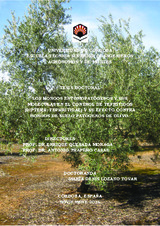Mostrar el registro sencillo del ítem
Los hongos entomopatógenos y sus moléculas en el control de trefítidos (Diptera: Tephritidae) y su efecto contra hongos de suelo patógenos de olivo
| dc.contributor.advisor | Quesada-Moraga, Enrique | |
| dc.contributor.advisor | Trapero Casas, Antonio | |
| dc.contributor.author | Lozano Tovar, María Denis | |
| dc.date.accessioned | 2016-01-26T09:51:09Z | |
| dc.date.available | 2016-01-26T09:51:09Z | |
| dc.date.issued | 2016 | |
| dc.identifier.uri | http://hdl.handle.net/10396/13201 | |
| dc.description.abstract | Esta tesis reúne el desarrollo de tres trabajos de investigación enfocados a la búsqueda de alternativas ecológicamente viables y eficaces para el manejo de las principales limitantes fitosanitarias del cultivo del olivo. Mediante un sistema de trabajo multidisciplinar entre los Grupos PAIDI AGR 163 “Entomología Agrícola” del departamento de Ciencias y Recursos Agrícolas y Forestales y PAIDI AGR 216 “Patología Agroforestal” del departamento de Agronomía, de la Universidad de Córdoba- España, se buscó dilucidar si los hongos entomopatógenos aplicados en el suelo para el control de estados preimaginales de tefrítidos, podrían tener impacto en otras comunidades de microorganismos presentes en el suelo, en particular los hongos fitopatógenos, que de ser antagonistas, supondría un manejo novedoso dentro del escenario del Control Integrado de Plagas y Enfermedades en el olivar... | es_ES |
| dc.description.abstract | Entomopathogenic fungi and their molecules for the control of Tephritids (Diptera: Tephritidae) and their effect on soil-borne pathogens of olive. This Doctoral Thesis gathers three researches focus on finding effective and feasible alternatives for the control of the phytosanitary problems of olive orchard, through a multidisciplinary approach between the PAIDI AGR 163 Group "Agricultural Entomology" of department of Sciences, Agricultural, and Forestry Resources and the PAIDI AGR 216 group "Pathology Agroforestry" of Department of Agronomy, University of Córdoba Spain. The current Doctoral Thesis explores if the entomopathogenic fungi (EF) applied in the soil for the control of preimaginal tephritids stages could impact on other soil-borne microorganism communities, such as fungal plant pathogens. The EF can be antagonist of olive pathogens. Besides, the work examines the possible dual biocontrol of both olive pests and diseases with EF, which would be a new strategy for the integrated management control of pest and disease in the olive orchard. The olive Olea europaea L. (Oleaceae) is an important crop in many countries and has acquired a large socio-economic importance within the Mediterranean region. The olive fruit fly Bactrocera oleae (Gmelin) and the olive pathogens Verticillium dahliae, Phytophthora megasperma and Phytophthora inundata are major worldwide limiting factors for olive tree production, they are causing the Verticillium wilt and root rot diseases, respectively. Although EF Metarhizium spp. and Beauveria spp. are well-known for insect pest control for many years, and in particular, for olive fly control by either targeting adults or pupariating larvae and puparia in the soil beneath the tree canopy, additional roles in nature have also been recently discovered, such as endophytic and rhizospheric interactions with plants, antagonism to plant... | es_ES |
| dc.format.mimetype | application/pdf | es_ES |
| dc.language.iso | spa | es_ES |
| dc.publisher | Universidad de Córdoba, Servicio de Publicaciones | es_ES |
| dc.rights | https://creativecommons.org/licenses/by-nc-nd/4.0/ | es_ES |
| dc.subject | Olivo | es_ES |
| dc.subject | Hongos entomopatógenos | es_ES |
| dc.subject | Tefrítidos (Diptera: Tephritidae) | es_ES |
| dc.subject | Hongos de suelo | es_ES |
| dc.subject | Microorganismos | es_ES |
| dc.subject | Control biológico de enfermedades de las plantas | es_ES |
| dc.title | Los hongos entomopatógenos y sus moléculas en el control de trefítidos (Diptera: Tephritidae) y su efecto contra hongos de suelo patógenos de olivo | es_ES |
| dc.type | info:eu-repo/semantics/doctoralThesis | es_ES |
| dc.rights.accessRights | info:eu-repo/semantics/openAccess | es_ES |

